India CSP

Provide Feedback
CloseShare With Contacts
CloseShare With Contacts
CloseCopy Link
Closehttps://indiacsp.shareableapps.com/
Tap and hold link above to copy to clipboard.
Delete Message?
Are you sure you want to delete this message?
An update is now available for this app!

You successfully shared the app
https://indiacsp.shareableapps.com/
Tap and hold link above to copy to clipboard.
Are you sure you want to delete this message?
You successfully shared the app
https://indiacsp.shareableapps.com/
Tap and hold link above to copy to clipboard.
Are you sure you want to delete this message?
India is one of the two 'giants' of Asia, and one of the world's fastest-growing economies. With a rapidly growing population of more than 1.3 billion, it is expected to overtake China as the world's most populous nation within a decade. And all the signs are that India's rapid economic expansion will continue, making it a compelling option for Australian businesses looking to expand into Asia.
Consider some key facts:
India is currently Australia's fifth-largest trading partner and its fifth-biggest export market. In 2017, Australia exported goods and services worth about AUD 20.16 billion to India, while our imports from India totalled just over AUD 7.2 billion.
In an effort to further deepen trade links, the nations' two governments began negotiating the Australia-India Comprehensive Economic Cooperation Agreement (CECA) in 2011. The negotiations are ongoing, and when agreed upon will bring to fruition another in a series of bilateral trade agreements between Australia and its key partners in the Asian region.
The following sectors of the Indian economy could present opportunities for Australian businesses:
Resources and mining: More private sector participation has emerged in the last decade, and the Indian Government is focused on amplifying the efficiency and profitability of the local mining sector.
Agriculture: Currently, India contributes to one per cent of the global food trade and the Government is aiming to double this figure.
Food and food products: The increasingly affluent middle class is generating big changes in dietary habits. Demand is increasing for animal-based protein-rich foods, value-added and processed food products, wine, beer, jams, honey, canned meat and vegetables, health foods and baby foods.
Education: In 2017, Indian student enrolments in Australia accounted for 13 per cent of all international enrolments. Enrolments from India grew approximately 9 per cent in 2016 and over 14 per cent in 2017, making it one of the fastest growing sources of international students in Australia.
Information communications technology (ICT) and services: India's ICT market is growing exponentially, and now accounts for 45 per cent of the nation's services exports. Mobile technology in particular is seeing unprecedented uptake, with 10 million new subscribers each month. Significant opportunities exist across banking and financial services, logistics and value chains, health-related IT and mobile applications, as well as media and entertainment.
Biotechnology and pharmaceuticals: India's biotechnology sector is the third largest in the Asia-Pacific, and is expected to keep growing at an annual rate of 30 per cent.
Aged care: The number of people aged over 65 in India is forecast to quadruple over the next 40 years, prompting greater demand for healthcare and aged care services.
Automotive: India is the world's fifth-largest automobile producer, with output growing just under 15 per cent in the last 10 years. With only about one per cent of India's population owning a passenger car, the potential for growth is enormous.
Rail infrastructure: The state-owned Indian Railways is beginning to court private investment to support its freight and passenger train operations.
Water, waste and environment: Population and economic growth is escalating the demand for fresh, clean water. Opportunities for Australian businesses include the provision of expertise to control industrial pollution, treat wastewater and effluent water, manage riverfronts and protect the shoreline.
Tourism: Annual revenue from Indian visitors to Australia, currently at about AUD 1.4 billion, is expected to grow to AUD 2.3 billion by 2020. In 2017, a total of 300,000 Indians visited Australia, a 23 per cent increase on the previous year.

For more information, access the full India Country Starter Pack
You successfully shared the app
https://indiacsp.shareableapps.com/
Tap and hold link above to copy to clipboard.
Are you sure you want to delete this message?
India is the world's seventh-largest country, occupying 3.287 million square kilometres. Its climate is very diverse, with cool winters and relatively hot summers in northern India, while southern states have a more humid climate year-round, with tropical rainforests in the south-west.
India recognises four distinct seasons, namely winter (January to February), summer (March to May), monsoon season (June to September) and the post-monsoon period (October to December). In many of the urban parts of India, summer temperatures can be as high as 45°C.
India has a rich history dating back thousands of years. The ancient Indus Valley Civilisation can be traced as far back as 7500 BCE. The Gupta Empire, which spanned the early fourth to the late sixth century CE, is regarded as India's Golden Age.
Europeans first visited India in 1498, when a Portuguese fleet led by Vasco da Gama discovered a new sea route from Europe to Asia. The British East India Company arrived in 1617, and by the 1850s controlled much of South Asia. British Raj (or British Crown rule) followed.
Mahatma Gandhi was one of several leaders who began peaceful mass movements against British rule in 1920. On 15 August 1947, the partition of India saw the British Raj cede control, creating the sovereign states of India and Pakistan. It is estimated that close to a million deaths resulted from the religious violence that preceded partition. Fearing persecution by the religious majority in the newly formed states of India and Pakistan, more than 14 million Hindus, Sikhs and Muslims moved across the border at the time of partition, the largest mass migration in modern history. Religious tensions have simmered beneath the surface of Indian society since partition, and have resulted in the assassination of at least six political leaders.
Modern Indian culture has developed over several millennia and is richly diverse, informed by a wide range of religions, languages and traditions. A large proportion of Indians are deeply religious, and religion is a key influence on the nation's culture.
The primary unit of Indian society is the family. A strict generational hierarchy is followed, where elders are respected and revered, with the onus of caring for older people resting on the next generation.
There is continuing debate on whether India's caste system could still be considered strict or widespread. Although there is still a stigma in some communities around dalits, or untouchables, today's Indian workplace is largely meritocratic.
Like Australia, India has a strong sporting culture. The friendly rivalry between our cricket teams can be a helpful ice breaker when forming relationships with Indian contacts.
Religion informs many Indians' cultural beliefs and practices. India is the birthplace of four religions: Hinduism, Buddhism, Jainism and Sikhism. Almost 80 per cent of the population are Hindus, while just under 15 per cent are Muslims.
Many of Hinduism's principles are shared by all of India's people, regardless of religious belief. For instance, the sacred status of cows is broadly embraced across the country; their slaughter is prohibited and beef is banned in a number of states.
The Republic of India is a constitutional democracy comprising 29 states and seven national and union territories. The Prime Minister is Head of Government, and a President acts as Head of State in a largely ceremonial capacity. All 36 states and union territories have their own governments.
The 2014 national Indian election was won by the Bharatiya Janata Party (BJP), one of India's two main political parties, with its centre-right coalition partners under the banner of the National Democratic Alliance (NDA). The current leader of the BJP is Prime Minister Narendra Modi. The BJP is a strong proponent of foreign investment in priority sectors such as infrastructure, as well as privatisation of government-owned companies.
An economic crisis in 1991 ignited a process of liberalisation, moving India towards a market-based economy. India is now the world's sixth-largest economy, when measured by GDP. According to the International Monetary Fund, India is currently one of the fastest-growing economies in the world and is expected to outgrow all other economies in 2018 - an expectation underpinned by Prime Minister Modi's introduction of economic liberalisation policies.
But India still faces impediments to economic progress, including poor infrastructure, low agricultural yields and low productivity, as well as relatively low ease of doing business. Average literacy rates and incomes remain relatively low. India is still home to about one third of the world's extreme poor, who make up a third of India's total population.
The Indian legal system is built on a unique combination of a common law system inherited from the British with statutory or regulatory law. The Constitution includes a guarantee of equal rights to its citizens and prohibits discrimination on a multitude of bases. The court system ranges from the Supreme Court down to village courts in rural areas.
Infrastructure development in India is expected to drive the economy over the next decade, with spending on infrastructure expected to reach nine per cent of GDP by the end of 2017. Among the aims are to connect all villages with all-weather roads, complete eastern and western dedicated freight corridors, ensure that 50 per cent of the rural population has access to piped drinking water, and upgrading major highways. Electricity and telecommunications infrastructure are also a key focus.
For more information, access the full India Country Starter Pack
You successfully shared the app
https://indiacsp.shareableapps.com/
Tap and hold link above to copy to clipboard.
Are you sure you want to delete this message?
Two-way trade in goods and services between Australia and India totalled just over AUD 27.4 billion in 2017. Major Australian exports to India included coal (AUD 9.2 billion), education-related travel (AUD 3.4 billion) and vegetables (AUD 1.38 billion). Our main imports from India were refined petroleum (AUD 1.6 billion), medicines (AUD 335 million), pearls and gems (AUD 274 million) and railway vehicles (AUD 199 million).
The total stock of Australian investment in India totals AUD 13.9 billion, while Indian investment in Australia is almost AUD 15.5 billion. Australian investment in India covers a range of sectors, including manufacturing, telecommunications, hotels, minerals processing, food processing, oil and gas, and the automotive sector.
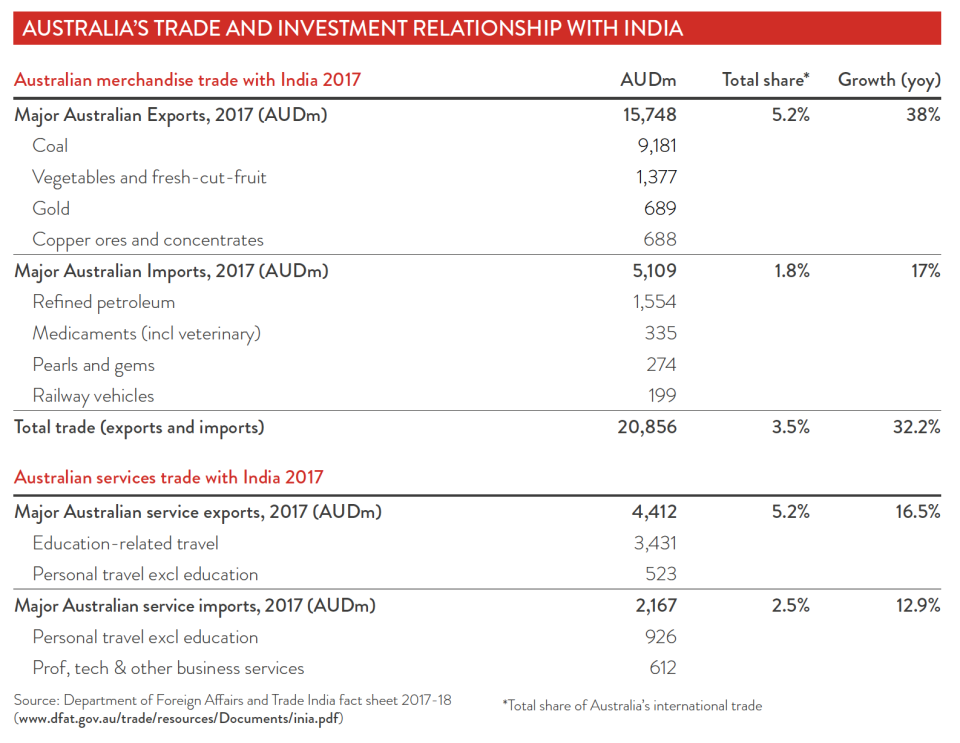
For more information, access the full India Country Starter Pack
You successfully shared the app
https://indiacsp.shareableapps.com/
Tap and hold link above to copy to clipboard.
Are you sure you want to delete this message?

You successfully shared the app
https://indiacsp.shareableapps.com/
Tap and hold link above to copy to clipboard.
Are you sure you want to delete this message?
You should develop an India strategy before deciding how to launch your business there. In particular:
India is a country of incredible regional diversity, with a wide range of income levels, culture, language, education, skill levels, market preferences and consumer tastes. This will affect how and where you do business.
Different cities and regions are becoming more specialised in their economic and business functions. Mumbai is the financial centre and Bangalore its Silicon Valley, while Pune is the automotive hub of India and has a rapidly growing IT sector.
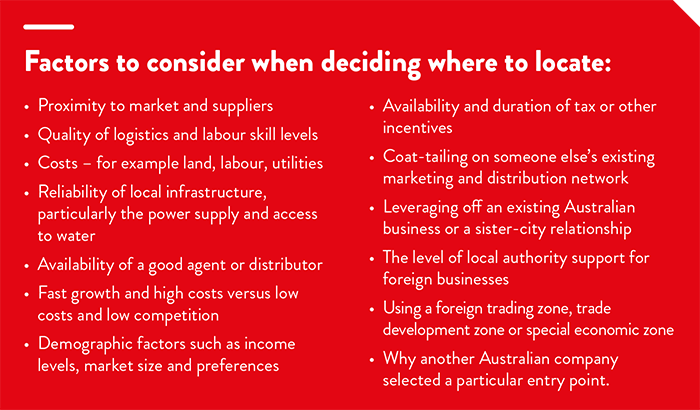
India has different types of special economic zones (SEZs), where laws governing trade and investment are more lenient than elsewhere in India. Many zones guarantee reliable access to power, water and medical facilities as well as skilled, price-competitive labour and single-window clearance on official processes. Other incentives and exemptions are available.
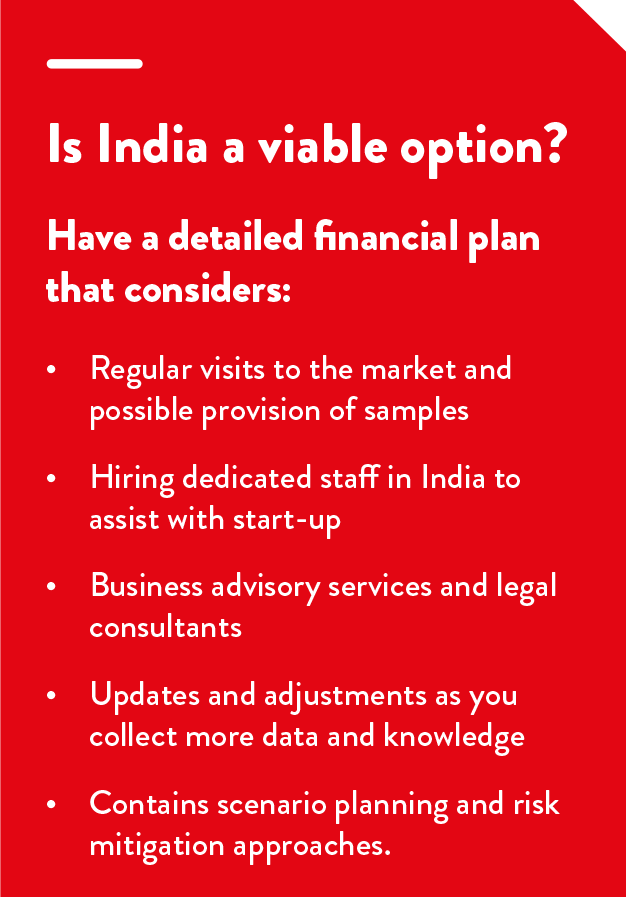
India's sovereign risk is moderate, with a BBB- credit rating from Standard & Poor's. Australia's Export Finance and Insurance Corporation (Efic) suggests there is a relatively low likelihood of India defaulting on its debt obligations. However, it still ranks relatively poorly on the World Bank scorecard for ease of doing business, coming 100th out of 190 countries in the 2018 Doing Business report. Efic has identified difficulties in enforcing contracts, paying taxes and gaining permits as the key business risks in India. Corruption is also a relevant concern. In 2017 India was ranked 81 out of 180 countries on Transparency International's Corruption Perceptions Index.
For more information, access the full India Country Starter Pack
You successfully shared the app
https://indiacsp.shareableapps.com/
Tap and hold link above to copy to clipboard.
Are you sure you want to delete this message?
Comprehensive research is crucial when entering the Indian market. Consider the different geographies and markets within India, think about commissioning your own professional India-based research, and visit in person numerous times.

A variety of research organisations in India, including the big international professional and accounting firms, can be a major source of information. Austrade has offices in 10 major Indian cities, providing a range of services for Australian firms seeking to go offshore.
The Queensland, South Australian, Tasmanian, New South Wales, Victorian and Western Australian state governments have representative offices throughout India and may be able to assist with further information. The Australian Government's Export Market Development Grant (EMDG) scheme can help meet these costs and state and territory governments may provide grants too.
You will need to visit India to develop a deeper understanding of your target market and make contacts.
Visit before entering agreements with prospective agents, distributors or other business partners. Consider meeting with several potential partners to give you a basis for comparison. Arrange in-country assistance to help set up your program. This will help you see the right agents and customers who will be briefed and screened for interest and suitability. Numerous trade shows and exhibitions take place in India, and can provide an excellent opportunity to meet potential customers. Austrade and state governments organise regular trade missions to India.

Don't waste time in India doing what you can do in Australia. Various organisations have training courses or seminars that can expand your knowledge about doing business in India, including Asialink Business, Austrade, Export Council of Australia (ECA) and state and territory governments.
Prearrange as many of your meetings as possible and reconfirm them a day in advance. Within 48 hours of your appointment, send an email thanking your contact for the meeting and providing any follow-up information.
Many Australian cities have sister-city relationships in India, including those between Melbourne and New Delhi, Ipswich (QLD) and Hyderabad, Rockingham (WA) and Kalyanpur, and Brisbane and Lucknow. These relationships provide networking events and an established contact base.
Joining a business association, such as AustCham, is a great way to learn more about the local business community. The Australia India Business Council (AIBC), Indo-Australia Chamber of Commerce, and Federation of Indian Chambers of Commerce and Industry (FICCI) could all be useful.
For more information, access the full India Country Starter Pack
You successfully shared the app
https://indiacsp.shareableapps.com/
Tap and hold link above to copy to clipboard.
Are you sure you want to delete this message?
There are five primary entities for foreigners to choose from:
If do not want to set up an entity, you can pursue other avenues to sell your product in India, either via an agent or distributor. Note that e-commerce websites in India require you to have an Indian business address and cannot solely be operated from elsewhere.
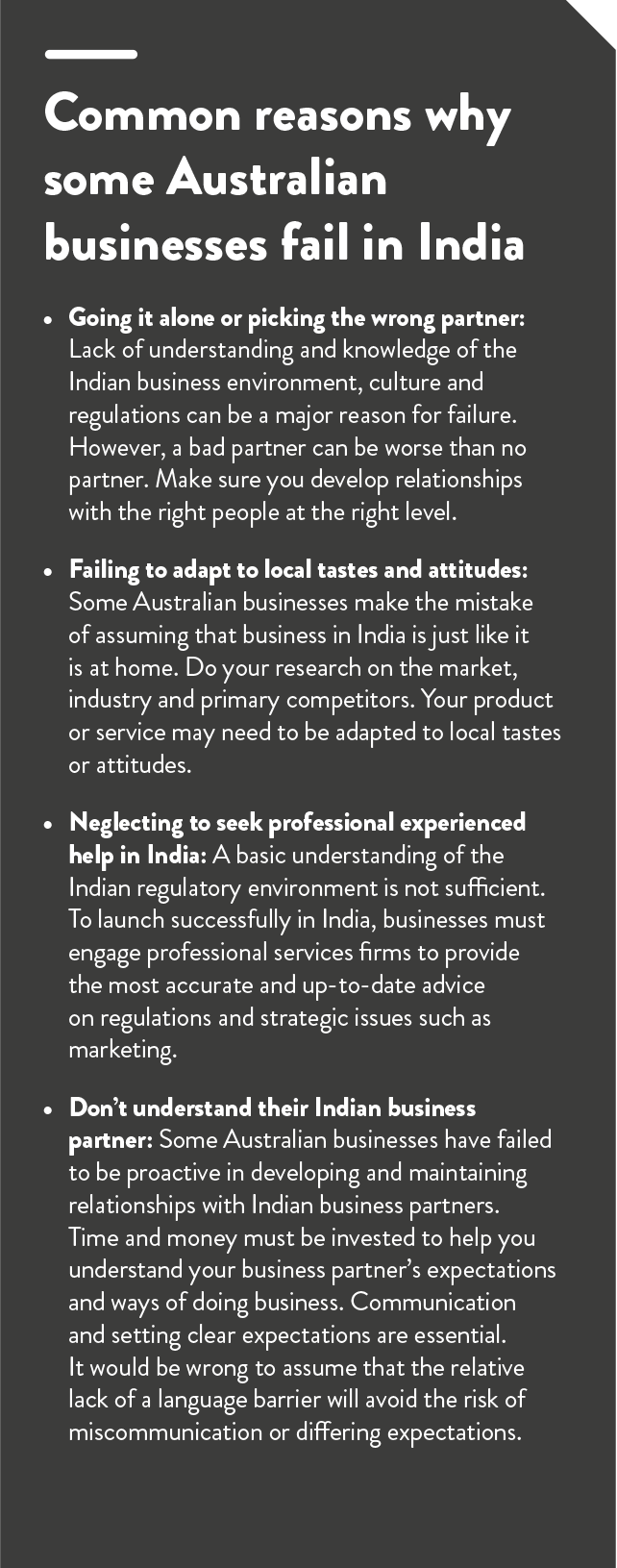
Foreign businesses most commonly establish either a public or private LLC, with the latter being the more popular choice as it offers greater freedom of operations and fewer regulatory requirements. Private LLCs are required to have at least two directors, one of whom must be an Indian resident.
Establishing as an LLP provides a flexible option for businesses that require flexibility in setting up their organisational structure. Full foreign ownership is prohibited in agriculture, print media and real estate. LLPs require at least two partners, with at least one needing to be an Indian resident. An LLP with foreign partnership and a foreign capital contribution requires approval from the Foreign Investment Promotion Board (FIPB).
A partnership firm requires two or more people to be involved, one of whom must be an Indian resident. Under India's current Foreign Direct Investment policy, any foreign investment in partnership firms is subject to approval from the Reserve Bank of India (RBI).
If setting up your business as a branch office of your Australian goods business, you must obtain approval from the RBI. Branch offices are allowed to operate for an initial three years, but extensions can be applied for. A branch office is permitted to carry out only a small range of business activities, and cannot manufacture goods in India.
Liaison offices could be the best business structure for your business if you simply want to establish an on-the-ground presence for your company. Operations within the liaison office must be confined to collecting information about market opportunities and providing prospective customers with information. The liaison office is prohibited from earning any income or undertaking any business activities in India.
If your business is looking to execute a specific project within a stipulated timeframe in India, a project office could be the most suitable structure. In this case, RBI approval is not necessary, as long as you have secured a contract from an Indian company to carry out specific work in India, and submit a report to the jurisdictional regional office of the RBI.
For more information, access the full India Country Starter Pack
You successfully shared the app
https://indiacsp.shareableapps.com/
Tap and hold link above to copy to clipboard.
Are you sure you want to delete this message?
The Modi government intends to re-establish India as an attractive destination for manufacturing through its 'Make in India' campaign designed to attract foreign direct investment.
India's manufacturing sector is backed by strong technical and engineering capabilities and a high degree of expertise. However, the average skill level of the labour force is arguably lower than in some neighbouring countries. This can be a positive, as a lower-skilled workforce can mean lower manufacturing costs.
Major manufacturing hubs in India include Mumbai and Pune in Maharashtra, Gujarat, Tamil Nadu and West Bengal.

For more information, access the full India Country Starter Pack
You successfully shared the app
https://indiacsp.shareableapps.com/
Tap and hold link above to copy to clipboard.
Are you sure you want to delete this message?

You successfully shared the app
https://indiacsp.shareableapps.com/
Tap and hold link above to copy to clipboard.
Are you sure you want to delete this message?
Most Australian firms doing business in international markets rely on agents or distributors. The roles of agents and distributors are often confused, so it is important to understand the difference between them. There are no laws or regulations covering agents and distributors in India, you will have to rely on contracts to define the relationship and enforcement.
Agent: An agent represents the supplier, but does not take ownership of the goods. They generally earn a commission based on an agreed percentage of sales value generated. Usually India-based, they often represent numerous services or product lines, operating as the sole agent for a company's goods or services in that market, or as one of a number of agents.
Distributor: Buys the goods from the exporter then resells them to local retailers or consumers. Distributors may carry complementary and competing lines and usually offer after-sales service. Their fees are higher than agents' because of associated costs. They usually carry inventory, but Indian distributors rarely take on marketing.
Choosing an agent or distributor: The most important thing is that you can establish a close working relationship. Meet with a potential partner to get to know them and observe their knowledge and presence in their own market. Get trade references and consider professional credit checks.
For more information, access the full India Country Starter Pack
You successfully shared the app
https://indiacsp.shareableapps.com/
Tap and hold link above to copy to clipboard.
Are you sure you want to delete this message?
Internet usage in India has grown dramatically in the last decade. In 2017 India was the second largest internet market after China, with an estimated 481 million users. This is projected to grow to around 635.8 million users by 2021, or 44 per cent of the population. Yet despite the large number of users, only 36 per cent of the population accessed the internet in 2017.

Some key characteristics of the Indian e-commerce market identified by Boston Consulting Group are:
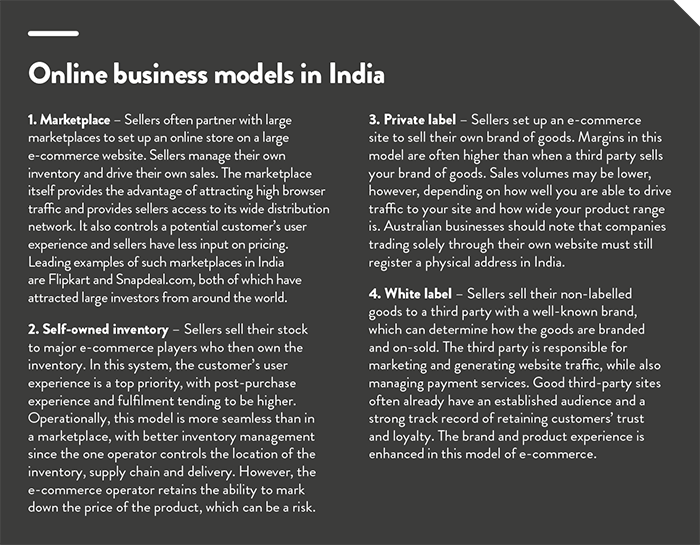
For more information, access the full India Country Starter Pack
You successfully shared the app
https://indiacsp.shareableapps.com/
Tap and hold link above to copy to clipboard.
Are you sure you want to delete this message?
The direct selling industry took off in India in the 1990s, when large global direct selling companies like Amway, Avon and Tupperware established Indian operations. Today, annual revenue from direct sales in India amounts to around INR 126.2 billion (AUD 2.5 billion), the majority of which is generated by large international players. The direct sales market in India is expected to reach INR 159 billion by 2021.
For more information, access the full India Country Starter Pack
You successfully shared the app
https://indiacsp.shareableapps.com/
Tap and hold link above to copy to clipboard.
Are you sure you want to delete this message?
Franchising has become very popular in India, particularly in the food and beverage industries and in retail and business services. There are no specific laws regulating franchising in India, which means you should seek professional legal advice.
For more information, access the full India Country Starter Pack
You successfully shared the app
https://indiacsp.shareableapps.com/
Tap and hold link above to copy to clipboard.
Are you sure you want to delete this message?
India is one of the largest consumer markets in the world, with its population of middle-class consumers expected to reach 200 million in 2020 and 475 million in 2030. But it is a complex and diverse consumer market, and it is vital to tailor your marketing strategies to local preferences.
The best way to deal with these complexities is to invest in and hire local knowledge. Both Indian and international companies specialise in marketing in India. You should be particularly mindful of factors including:
Trade shows and exhibitions: An effective way to reach potential new customers is to visit one of the many trade shows and exhibitions that are frequently held across India. Variants of these occasionally take place in Australia's major cities.
Product and service adaptations: You may need to adapt your product to meet Indian preferences or requirements. Adapting to local regulations, tastes and cultural preferences vastly improves your chances of success.
Brand marketing and advertising: Language, culture and symbolism need to be considered when marketing and advertising in India. Generally, you can preserve your English company name when trading in India, but check that it does not have a negative meaning when translated. Names indicating excellence, power and sophistication are well received. In the health and wellness market, names referencing peace, soul, happiness and freedom will be popular with consumers.
For more information, access the full India Country Starter Pack
You successfully shared the app
https://indiacsp.shareableapps.com/
Tap and hold link above to copy to clipboard.
Are you sure you want to delete this message?
India has strict rules for product labelling, particularly when dealing with vegetarian and non-vegetarian food indicators, as well as food safety. Labelling requirements vary between three primary product categories: prepackaged food, wholesale packages and primary food. Indian Customs inspect all imported items to ensure that they are correctly labelled before allowing them to enter the retail market. All pre-packaged goods intended for retail sale, directly or otherwise, must have the following information clearly stipulated on the label:
The information may be printed in English or Hindi, either on the packaging itself or affixed to any additional wrapping within which the imported package will sit. The threshold for raw materials or components of a product that will be processed further before sale is lower. Always remember to pack your consignment thoroughly and tightly. Packages may be handled roughly by customs and other handlers, and it is not uncommon for packages to be left in the open air for longer than you would expect, especially if there is a backlog of shipments to approve.
For more information, access the full India Country Starter Pack
You successfully shared the app
https://indiacsp.shareableapps.com/
Tap and hold link above to copy to clipboard.
Are you sure you want to delete this message?
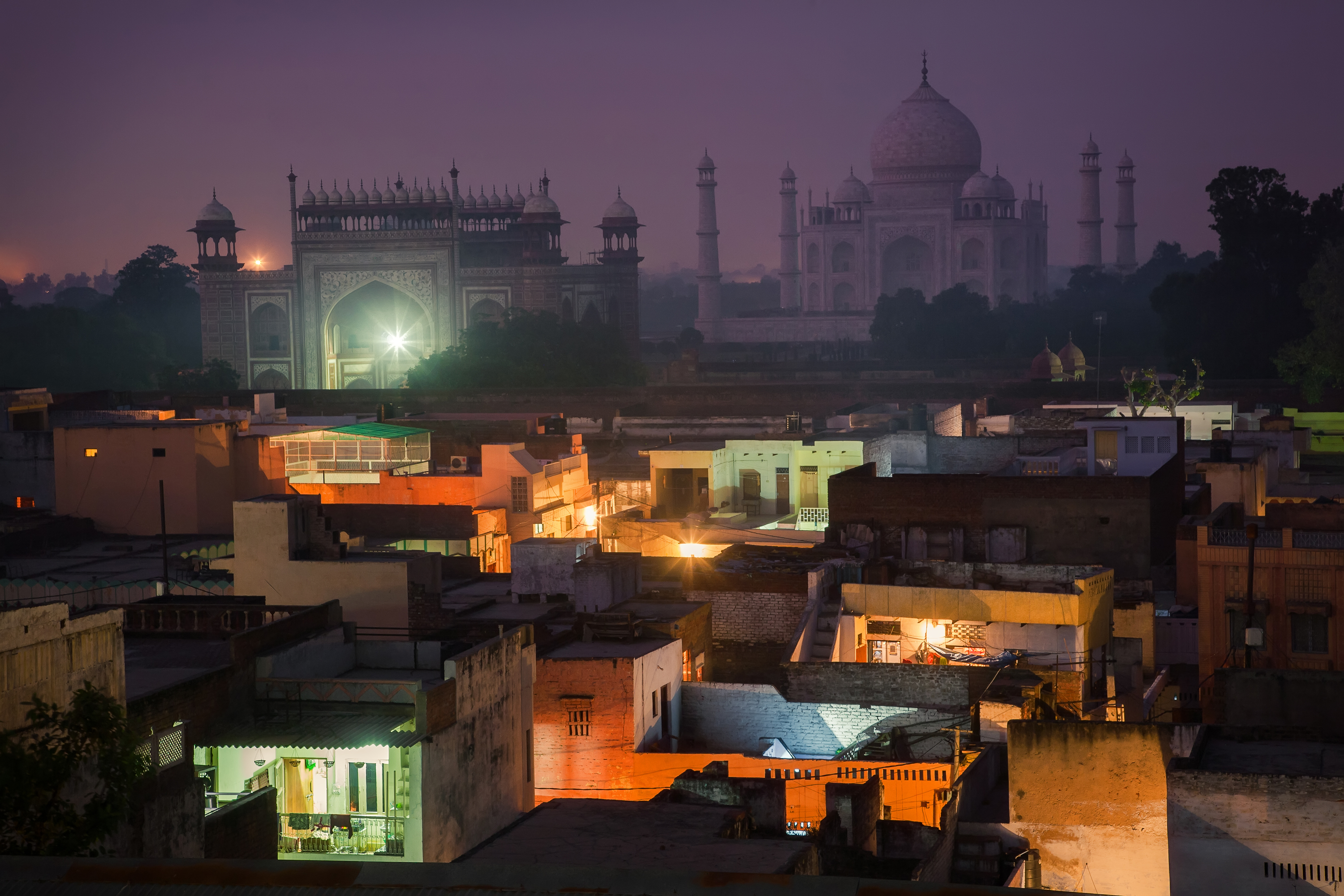
You successfully shared the app
https://indiacsp.shareableapps.com/
Tap and hold link above to copy to clipboard.
Are you sure you want to delete this message?
Indians are strongly guided by their respective religions and shared values. Respect for elders and hierarchy are core values that permeate all aspects of society. Indians also place huge importance on family and community. And the concept of saving face – avoiding blame or any type of shameful situation – can affect your business dealings. Positions of power and authority are highly valued and revered.
Building good business relationships and trust are important in India, so expect to spend plenty of time at meetings, dinners and social clubs with potential business partners. As in some other Asian cultures, Indians like to develop a personal connection first. So expect to be asked – and prepare to ask your own questions – about family.
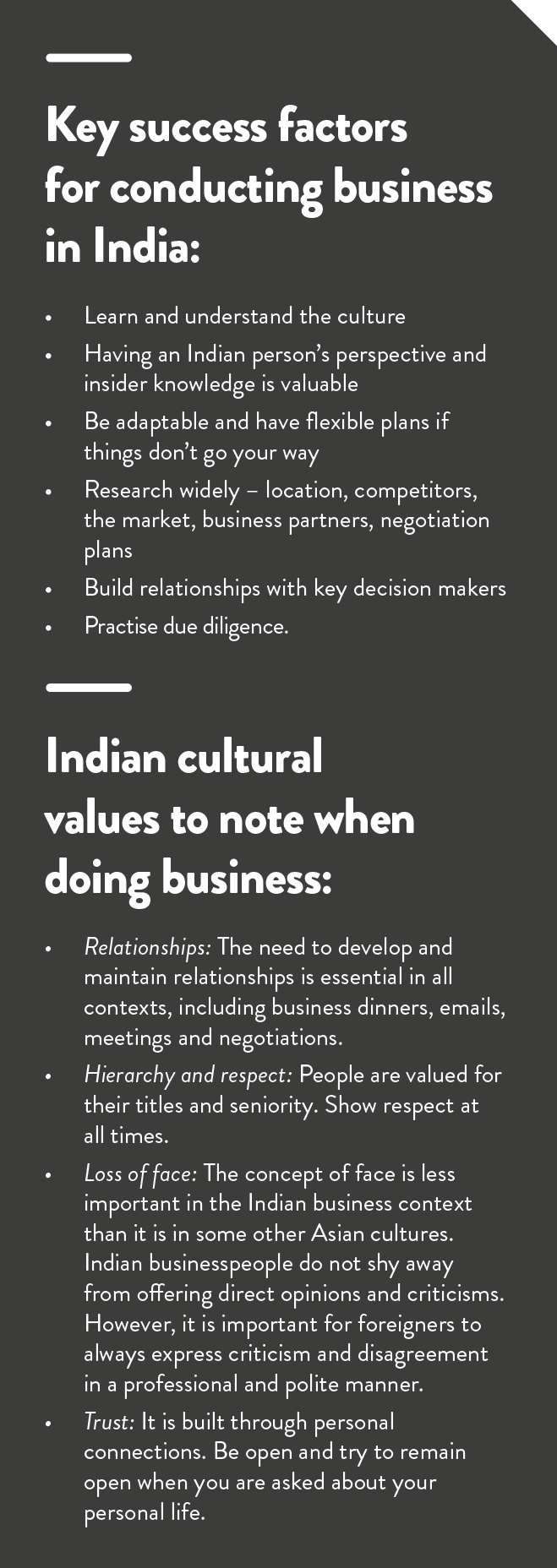
Greetings and titles: A handshake is the standard way to greet men and women in a business setting. When meeting with small independent retailers in non-urban areas, you may be greeted with the word namaste (pronounced nah-mas-tay). It is acceptable to address senior men and women using their honorifics (Dr/Mr/Ms) and their first names or surnames.

Body language: Indians are generally expressive and use body language to convey messages that are not always verbal. Clarify verbally if you think you are getting a “yes" response.
Showing the soles of your feet or shoes, or pointing your feet towards anyone, is considered highly disrespectful, as is stepping on or over papers, books, religious offerings on the ground – and especially people. It is rude to touch anyone's head, and pointing with fingers is also disrespectful.
Business cards: These are essential when conducting business in India and must be handled with respect. Make sure your card includes your name, company name, position and email address, all in English (it is not necessary to have your card translated into Hindi).
Corporate culture: Make sure the person you are negotiating with is senior enough to commit to decisions. Do not begin business meetings by getting straight to the heart of the negotiation. Take a short time to ask personal questions about your contact's family and background.
Do not expect negotiations to be completed at the first meeting. And be aware that Indians are reluctant to say “no" – you may be told that something is possible even when it is not. Asking for further detail about how something will be done could help to uncover whether your contact will be able to fulfil your needs. On the other hand, you may be told something is impossible to do if your contact thinks it will be expensive, complicated or tedious. Ask again firmly, but with a smile if you think that your request is a reasonable one.
Dress code: Conservative, professional attire is expected in the business setting. Men should generally wear a suit (with tie) and women should wear a business dress or a suit with a blouse. In summer, however, it is more acceptable for men to not wear a jacket. Women should avoid wearing short outfits or exposing their shoulders.
For more information, access the full India Country Starter Pack
You successfully shared the app
https://indiacsp.shareableapps.com/
Tap and hold link above to copy to clipboard.
Are you sure you want to delete this message?
In Australia's International Business Survey for 2016, 75 per cent of respondents identified 'local language, culture and business practices' as impediments to business success in India. Some of these obstacles can be overcome by spending extensive time in India and investing effort into building relationships with contacts.
General knowledge of India: It is helpful to have some general knowledge of India and its culture, which can help establish an immediate connection with a new Indian contact.
Formal introduction: Indians tend to prefer to do business with people they know, or with whom they have a personal connection. It can help to be introduced to a prospective business associate through an intermediary.
Conscious effort: Relationships in India, as in many parts of Asia, are more trust-oriented and personal than elsewhere; a conscious and continued effort is therefore required to develop and maintain them. This will require frequent visits, almost daily communication and plenty of socialising.
Gifts: Gifts are not normally expected at initial meetings but can be a positive gesture when you have concluded a business negotiation or are marking a milestone in the business relationship. Chocolates, small china or crystal gifts can be appropriate, as can items with Australian symbolism or which display your company emblem.
Dining and entertainment: Once you have established relationships in India, you are likely to be invited to lunches or dinners. An invitation to dine at your contact's home is a signal that your relationship is becoming deeper and that you are a trusted contact. In business negotiations, dining is commonly used to gently probe positions without any formal commitment. Business is generally not discussed in depth during meals; their main purpose is to build trust and relationships.

To find the right partner, it may help to have a team of on-the-ground professional advisers and agents to seek out appropriate targets, conducting a market analysis of players, meeting stakeholders and officials, and building relationships.
In meetings or video conferencing, ensuring the most senior executive of the Australian company is available will help ensure that the needs of your company are prioritised by your Indian business partner.
Young Indian entrepreneurs are blessed with a huge domestic consumer market and are less enthusiastic about partnering with foreign firms. Australian businesses that offer innovative technology or expertise may fare better when seeking Indian partners. On the other hand, many major Indian corporations are looking to outsource their research and innovation to foreign companies.
While some regulations are imposed centrally in India, an additional layer of state regulations and laws often apply. This means foreign businesses need to cultivate relationships with local, state and municipal government officials.
The following is a list of the main government agencies for Australian businesses looking to do business in India:
For more information, access the full India Country Starter Pack
You successfully shared the app
https://indiacsp.shareableapps.com/
Tap and hold link above to copy to clipboard.
Are you sure you want to delete this message?
Address your counterparts by their titles (chairman, president or otherwise). After establishing who is the most senior person in the room, address them first.
It is helpful to share an agenda or at least the objectives of the meeting beforehand. The discussion normally begins with general topics, before turning to more specific topics, followed by the purpose of the meeting. Discussions are primarily between the two leaders, although either may elect to include others in the exchange. Select one person – yourself or the most senior team member – to be your group spokesperson.
Do not interrupt someone when they are speaking in a meeting, and do not challenge anyone directly, or put them on the spot by asking for information they seem unwilling to give.
In India, negotiations are tackled with distributive (zero-sum or win-lose) and contingency bargaining. The buyer is generally in a superior position although whether or not you are the buyer, you should make reasonable efforts to reach an agreement. Appearing to be willing to compromise, and displays of respectful friendliness, will help you to reach a resolution.
Negotiation in India is primarily seen as a process to build trust – so that the two parties can together achieve an outcome benefiting both, while building long-term trust and relationships. Negotiations can be slow or protracted, especially when dealing with bureaucrats. Often it can take several meetings and trips to India before reaching an agreement.
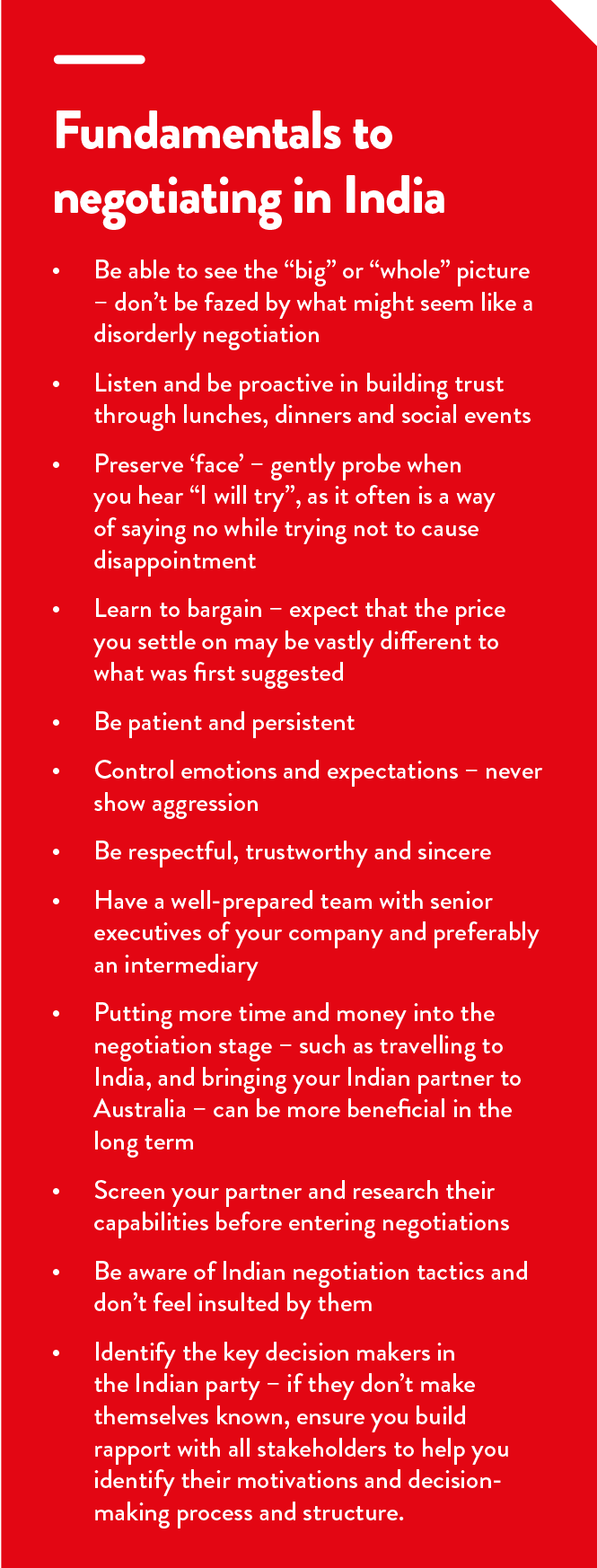
For more information, access the full India Country Starter Pack
You successfully shared the app
https://indiacsp.shareableapps.com/
Tap and hold link above to copy to clipboard.
Are you sure you want to delete this message?
India's laws are robust. Its judiciary, however, is less efficient and reliable so you will want to do as much due diligence as you can to avoid going to court later, and to protect your reputation and your business. Fraud, scams and corruption are ongoing challenges.
Australian firms planning to operate in India should commit to the highest level of corporate behaviour and familiarise themselves with Australian laws and penalties for bribery. Australian individuals and companies can be prosecuted in Australia for bribing foreign officials when overseas.
There are various ways to carry out due diligence in India. It is strongly recommended that you seek professional advice to develop strategies for your business' unique situation. Your due diligence process should begin with a basic background check to ensure you carefully choose which businesses you trade with or partner with. Request basic information on their existing customers and ask to inspect their operations.
For more information, access the full India Country Starter Pack
You successfully shared the app
https://indiacsp.shareableapps.com/
Tap and hold link above to copy to clipboard.
Are you sure you want to delete this message?

You successfully shared the app
https://indiacsp.shareableapps.com/
Tap and hold link above to copy to clipboard.
Are you sure you want to delete this message?
India's economic liberalisation policies of the early 1990s have been given a boost by the Modi Government, which has removed foreign investment caps in industries including telecommunications, medical devices and single-brand retail, while allowing greater foreign investment in others. The policies are boosting investor confidence, as evidenced by India being ranked 11th in A.T. Kearney's FDI Confidence Index in 2018.
Foreign investment in India can follow the Government Route, through which investments in some industry sectors must be approved by the Central Government, or the Automatic Route, which applies to all other industries. Aggregate foreign investment exceeding INR 30 billion requires approval of the Cabinet Committee on Economic Affairs of the Central Government.
The Government's 'Make In India' initiative is a major national program aimed at facilitating investment that will foster innovation, upskill the workforce and build world-leading infrastructure. See makeinindia.com and investindia.gov.in for more information.

Both the Central Government and state governments offer incentives to invest in India. The Central Government offers a number of different incentives (largely tax-based) for companies to invest in or set up in Special Economic Zones (SEZs), National Investment and Manufacturing Zones (NIMZs) and Export Oriented Units (EOUs). The Government also offers incentives for companies planning to manufacture in India for export. There are also incentives for setting up in less developed areas of India, and sector-specific incentives. Each state government has its own incentives, policies and programs.
You will need to negotiate myriad legal and financial rules to acquire or lease premises. This is something your business will need to deal with early, as you will require a business address to register your company. A foreign national of non-Indian origin who is resident outside India cannot purchase land or immovable property unless it is inherited. Generally, however, foreign businesses can get land use rights through a wholly foreign-owned enterprise or a joint venture.
The Foreign Exchange Management Act (FEMA) determines some of the prerequisites for land and property ownership in India. In order to purchase a property in India, without the need for RBI approval, an individual has to be a 'person resident in India' as defined in FEMA. You must ensure that you enter India on the type of visa that will allow you to purchase property.

Counterfeiting and scams are commonplace in certain Indian industries. For this reason, the United States has put India on its Priority Watch List of countries having “serious intellectual property rights deficiencies". The Indian Government is now concentrating on creating a more robust IP environment.
India has a 'first-to-use rule' for securing trademarks, giving the application that is filed the earliest superior rights to any subsequent applications. Trademarks may be invalidated if they are not used within five years. India's IP protection legislation also extends to customs regulations, which enforce cross-border measures to protect IP. Copyrights and patents can be registered in India, although patent examiners often raise clarity objections. Ten-year protection is also available for design. In all cases, your best chances of securing IP rights will come from seeking professional advice from a lawyer experienced in Indian IP laws and processes.
For more information, access the full India Country Starter Pack
You successfully shared the app
https://indiacsp.shareableapps.com/
Tap and hold link above to copy to clipboard.
Are you sure you want to delete this message?
Negotiation of the Australia India Comprehensive Economic Cooperation Agreement (CECA) is ongoing and both Australia and India have reaffirmed their commitment to a timely conclusion of the agreement. The trade negotiations aim to secure numerous benefits for Australian businesses, particularly those engaged in agriculture, manufacturing, services, investment, resources and energy. When CECA is signed and comes into effect, there may be certain goods to which no import duties apply. In other cases, import duties may be reduced, and eventually voided.
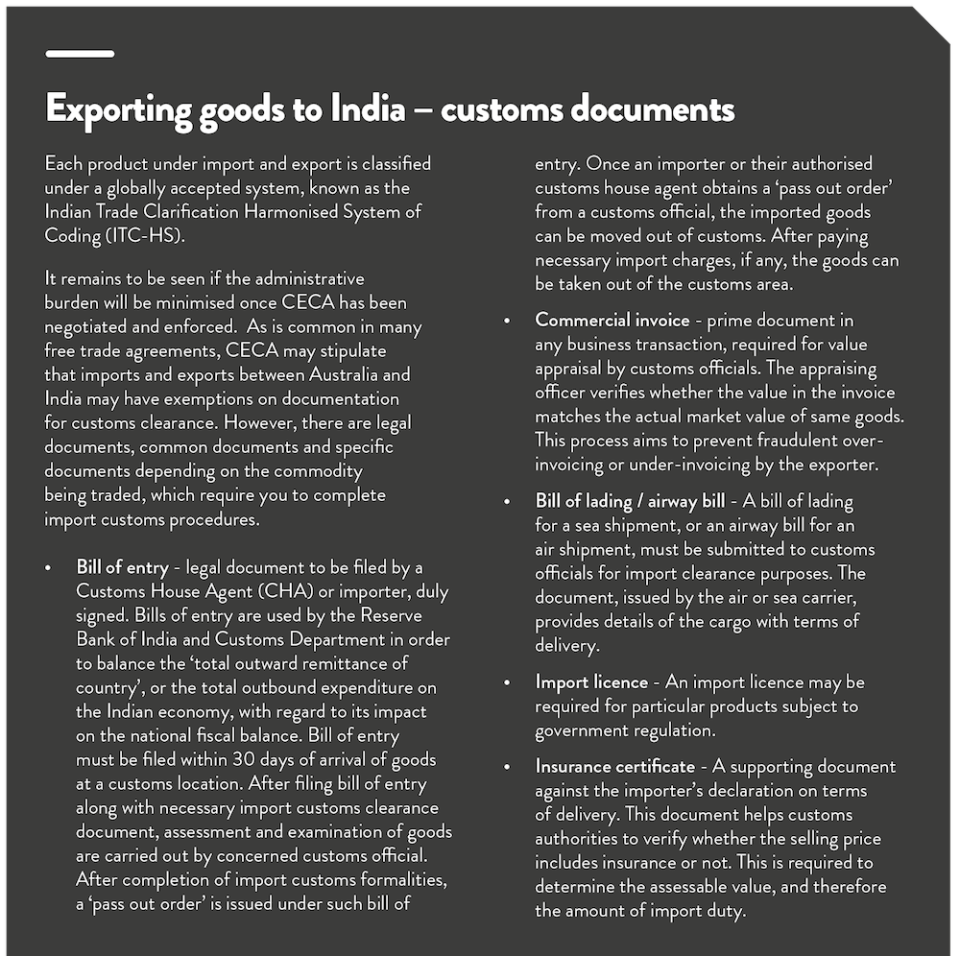
Tariffs are generally applied at a rate of 30 to 50 per cent on imported food products (calculated on the total cost including freight) and up to 150 per cent on foreign wines.
Import duties are calculated on either a quantity base – by applying an amount of duty per unit – or on an ad valorem (by value) basis.
Additional taxes and duties are also imposed on imported goods, although these may be reduced or not apply to goods imported through customs jurisdictions such as SEZs.
For more information, access the full India Country Starter Pack
You successfully shared the app
https://indiacsp.shareableapps.com/
Tap and hold link above to copy to clipboard.
Are you sure you want to delete this message?
India's tax system includes a wide range of imposts on businesses and individuals, including income taxes (corporate income tax and individual income tax), turnover taxes (value added tax, business tax and consumption tax), taxes on property (land appreciation tax and real estate tax), Goods and Services tax, stamp duty, customs duties and more.
The print and online versions of the India Country Starter Pack provide an overview of the primary taxes Australian enterprises need to consider when establishing a business in India, but they should seek professional advice on their business and its specific situation.
Applicable tax laws and policies will vary depending on the city and province in which a business is operating, as there can be additional local charges that may apply. For resident Indian companies, worldwide revenue is taxed. For non-resident Indian companies, only revenue generated in India is taxed.
The Government is tightening its regulations to stop both local and foreign companies avoiding taxes in India. From the 2016-17 financial year, the Government will assess applicable taxes by evaluating a company's place of effective management (PoEM), determined based on where key management and commercial decisions affecting business strategy and operations are made and put into effect. The Black Money (Undisclosed Foreign Income and Assets) and Imposition of Tax Act 2015 has also recently come into force, aimed at circumventing tax avoidance by those who may hold money overseas.
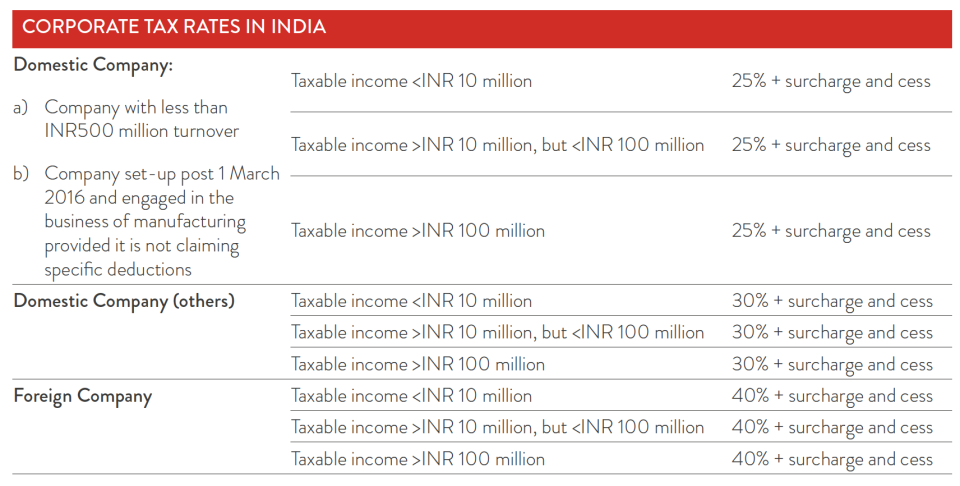
A range of tax incentives exist for investment, setting up in underdeveloped areas, infrastructure development, exports, hiring new staff, and some capital and research and development expenditure.
The tax year in India runs from 1 April to the following 31 March. Annual tax returns must be filed before 31 July of the succeeding year, and quarterly statements of taxes withheld are required. Other provisional reporting and payments must be made on either a quarterly or annual basis.
For more information, access the full India Country Starter Pack
You successfully shared the app
https://indiacsp.shareableapps.com/
Tap and hold link above to copy to clipboard.
Are you sure you want to delete this message?
Payment of tax: Tax is payable in advance if a business' payable tax for the year exceeds INR 10,000. The tax is paid in specified instalments for every quarter, before the 15th day of the succeeding month, during the tax year (April to March). Any balance of tax due on the basis of the return must be paid on a self-assessment basis before the return is filed.
Audit for income tax purposes: Those conducting a business are required to get their accounts audited for income tax purposes if the turnover is INR 10 million or more. For people engaged in a profession, the turnover threshold is INR 5 million.
General Anti Avoidance Rule (GAAR): GAAR provisions, introduced in 2017, empower the Indian revenue authorities to declare an arrangement entered into by a taxpayer to be an impermissible avoidance arrangement (IAA) if was not entered into with the primary goal of obtaining a tax benefit and directly or indirectly contradicts the provisions of the Income Tax Act. The GAAR applies to arrangements where the tax benefit exceeds INR 30 million.
For more information, access the full India Country Starter Pack
You successfully shared the app
https://indiacsp.shareableapps.com/
Tap and hold link above to copy to clipboard.
Are you sure you want to delete this message?
India is expected to have the world's largest labour force by 2030, and already there are about 460 million people of working age. Various factors are at play in this shifting landscape, including increased access to education due to a rapidly expanding middle class, growing foreign investment and strong economic growth.
Restrictive rules governing India's labour and employment landscape have long been identified as deterrents to foreign investment. However, the 'Make in India' initiative has had a positive impact on labour regulation, with the Government recognising that more investor-friendly and flexible labour laws are needed for the initiative to succeed. The power of trade unions in India is also something Australian businesses should be aware of.
Another issue facing Australian businesses wishing to establish operations in India is the relatively limited supply of experienced employees in both rural areas and developing urban cities. Relocating managers to these locations requires a raft of incentives and benefits, such as larger salaries and promotions. Recruiting managers locally is therefore a more cost-effective strategy.
Retention of talent tends to be more difficult in India than in Australia. Skilled professionals in particular are in very high demand, from both multinationals and large Indian corporations. The lure of better salaries and the prestige that comes with working for a world-renowned firm is contributing to high labour turnover, a costly prospect for businesses with limited resources relative to multinationals.
Various legislation affects employment in India, covering areas areas including workers' compensation, unionisation, industrial disputes, apprenticeships, factory work and provident funds. A local legal practitioner can advise on human resources and employment law.
Visas: An immediate priority will be understanding what type of visa you need to apply for if you are not a Person of Indian Origin or a Non-Resident Indian (as defined by the Indian government). The High Commission of India's website (www.hcindia-au.org/doing-business-in-india.htm) has more information.
Wages, salaries and other employee rights: Overlapping laws may appear to be inconsistent or in direct contravention of each other when it comes to employees' rights and remuneration. India has one of the lowest labour costs in Asia, with wages for manufacturing estimated to be about one third of those in China. If you employ more than 100 workers, a company policy must be drawn up to identify specific working conditions.
Working hours: Working beyond the hours for which you are salaried is quite common and this takes place without an expectation of compensation. Unionised workers will follow stricter time schedules, with an expectation of payment for overtime.
Leave: Depending on the state, there can be anywhere between 15 and 20 paid public holidays annually. Indian employees are entitled to at least 12 paid annual leave days each year. Full paid maternity leave of 12 weeks is the accepted standard.
Provident Fund Scheme, Pension Scheme and Insurance Scheme: India has a compulsory Provident Fund Scheme, administered by the Employee Provident Fund Organisation (EPFO). An alternative scheme is the Employees State Insurance Corporation (ESIC), which provides basic healthcare for lower-income earners. Employer contributions to the provident fund are compulsory and equal to 12 per cent of the employee's wage.
Unions: There are thousands of trade unions in India, the majority of which have banded together to form 12 major Central Trade Union Organisations (CTUOs). Each major CTUO is affiliated to a political party, which means they are extremely powerful.
Termination of employment: Protection from termination is provided by many of India's employment laws. Companies with more than 100 employees must obtain government approval in order to close an operation or lay off workers. This largely applies to labour-intensive companies, while companies in the services sector are exempt. Employees who have been with a company for more than five years are entitled to a gratuity at the rate of 15 days for every year worked when made redundant.
Workplace communication: In order to keep others from losing face, communication can often be non-verbal, so you must closely watch people's facial expressions and body language. Avoid referencing the caste system but be mindful of the subtleties in social hierarchy that may affect the way lower-level employees respond to local management.
The role of a manager: In India, as in other hierarchical societies, managers may take a somewhat paternalistic attitude towards their employees. Employees tend to show respect and deference to their managers and, in return, managers know their subordinates' personal situations and offer guidance. In more entrepreneurial companies, this may be changing.
Approach to time and priorities: Deadlines and timescales can be fluid in India if you are not dealing with senior managers and executives, so patience is crucial. Indirect communication styles between subordinates and superiors can delay timelines.
Boss or team player? A manager needs the respect of their staff. But when they need to work collectively with their team, they should state this and encourage the team to operate openly in a non-threatening environment. Expat managers should also encourage social interaction in and out of the workplace.

For more information, access the full India Country Starter Pack
You successfully shared the app
https://indiacsp.shareableapps.com/
Tap and hold link above to copy to clipboard.
Are you sure you want to delete this message?
India's banking market was once dominated by a small number of large domestic banks. In 2018, there are 45 private foreign banks (including Australia's ANZ, Commonwealth, NAB and Westpac) in India.
Oversight of financial institutions is maintained by the Ministry of Finance and the Reserve Bank of India. The State Bank of India (SBI) is India's biggest bank and the largest bank in the world by number of branches. SBI, HDFC Bank, Bank of Baroda and ICICI Bank are some of India's largest banks.
Australian businesses looking to maximise opportunities in India will probably need to work with a local bank. Some welcome the opportunity to lend to foreign companies and will usually have greater capacity to advance credit than most local offshoots of foreign banks. Domestic banks have large branch networks, relationships with state institutions, and established positions within Indian society, offering big advantages for Australian businesses entering India. Foreign banks do outperform their domestic peers in technology, including mobile banking and online user experience, as well as customer service and relationship management, including transparency.
For more information, access the full India Country Starter Pack
You successfully shared the app
https://indiacsp.shareableapps.com/
Tap and hold link above to copy to clipboard.
Are you sure you want to delete this message?
Most foreign capital invested in India is allowed to be repatriated after taxes have been paid. This includes any capital appreciation as long as the initial payment was made on the basis that the funds could later be repatriated. Dividends and other profits may also be repatriated as long as dividend distribution tax has been paid. Ensure that any repatriation you make complies with Reserve Bank of India (RBI) provisions.
Partners of an LLP can draw on capital according to the terms of the Foreign Investment Promotion Board's (FIPB) approval of the initial foreign direct investment. No distribution tax is payable in the case of an LLP.
Indian branches of foreign companies (excluding bank branches) may return profits to the overseas head office without prior approval. When a branch office closes, balances may be repatriated overseas, with RBI approval.
For more information, access the full India Country Starter Pack
You successfully shared the app
https://indiacsp.shareableapps.com/
Tap and hold link above to copy to clipboard.
Are you sure you want to delete this message?
You successfully shared the app
https://indiacsp.shareableapps.com/
Tap and hold link above to copy to clipboard.
Are you sure you want to delete this message?
India does issue some tourist visas on arrival, but only to citizens of 11 countries, of which Australia is not one. Check with your local consulate or the National Portal of India website about your eligibility under the Tourist Visa on Arrival scheme. It is highly likely that you will need to get a visa before travelling there, regardless of the purpose of your trip. Tourist and business visas may be obtained from the Indian High Commission in Canberra, and from the various Indian consular offices in other Australian cities.
There are two types of visas for travelling to India for work purposes – Business Visa (or B Visa) and Employment Visa (E Visa). The website of the High Commission of India in Australia – www.hcindia-au.org – contains detailed visa information.
For more information, access the full India Country Starter Pack
You successfully shared the app
https://indiacsp.shareableapps.com/
Tap and hold link above to copy to clipboard.
Are you sure you want to delete this message?
The principal unit of currency is the Indian rupee (INR). It is advisable to pay for your everyday items (including meals) in INR cash.
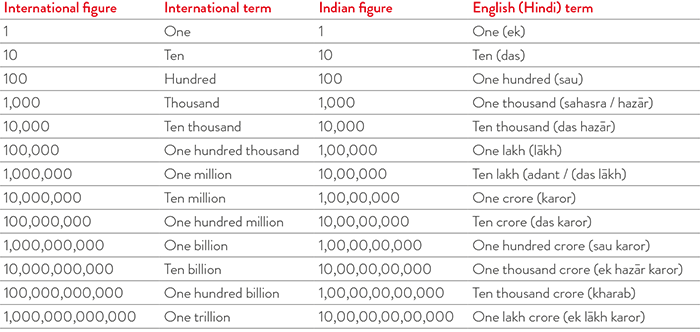
ATMs that accept foreign credit and charge cards for cash withdrawals are available at airports in large cities and in major hotels, and have English instructions. Credit cards are widely accepted in major cities, particularly in international hotels and restaurants. However, for everyday purchases from small shops, you will probably have to use cash.
For more information, access the full India Country Starter Pack
You successfully shared the app
https://indiacsp.shareableapps.com/
Tap and hold link above to copy to clipboard.
Are you sure you want to delete this message?
Most Australians enter India via the principal hubs of Indira Gandhi International Airport in Delhi, Chhatrapati Shivaji International Airport in Mumbai or Kempegowda International Airport in Bangalore. Always go to the official taxi rank outside the terminal. Have your hotel address written in English or Hindi characters to show to your taxi driver. Domestic air travel between cities in India is reliable and much more affordable than in Australia.
Metered taxis are plentiful and inexpensive in Indian cities. Only the blue and silver Cool Cabs are air-conditioned. Another option is to hire a taxi for a day, for a pre-negotiated price.
Auto rickshaws, referred to as autos, are far more plentiful than taxis in major cities such as Mumbai. They are metered and regulated by a government authority.
Most of India's major cities have growing mass transit rail systems. They are generally cheap, very fast and reliable. However, trains in cities with less developed rail systems can become very overcrowded. A monthly train pass in the general class costs INR 100 ($2.10) while a first-class one costs INR 500 ($10.50).
Bus transport is commonly used by Indians. At its worst, older non-air-conditioned vehicles get so overcrowded that you will often observe people almost hanging out of the doors while the vehicle is moving. More comfortable air-conditioned buses are also available.
Intercity express: India has an extensive national rail network that connects just about every city in the country. Train travel between cities is economical but delays are common. A one-way air-conditioned train ride from Delhi to Bombay ranges in price from INR 1537 to INR 3700 ($33-$79), depending on the class of travel.
For more information, access the full India Country Starter Pack
You successfully shared the app
https://indiacsp.shareableapps.com/
Tap and hold link above to copy to clipboard.
Are you sure you want to delete this message?
The Indian hotel industry is one of the world's largest, with an extensive range of price and budget levels. International chains and local luxury chains such as Taj, Oberoi and ITC operate in most major Indian cities. The Vivanta by Taj hotel chain is aimed at business travellers, and many of its hotels are located close to business centres or airports.
A significant amount of relationship building and some business in India is conducted during dining and entertaining outside of the office. Zomato India is a very popular service for finding restaurants. When in doubt, seek a recommendation from your hotel or from a trusted contact in India. Restaurants in hotels are a safe bet for entertaining clients.
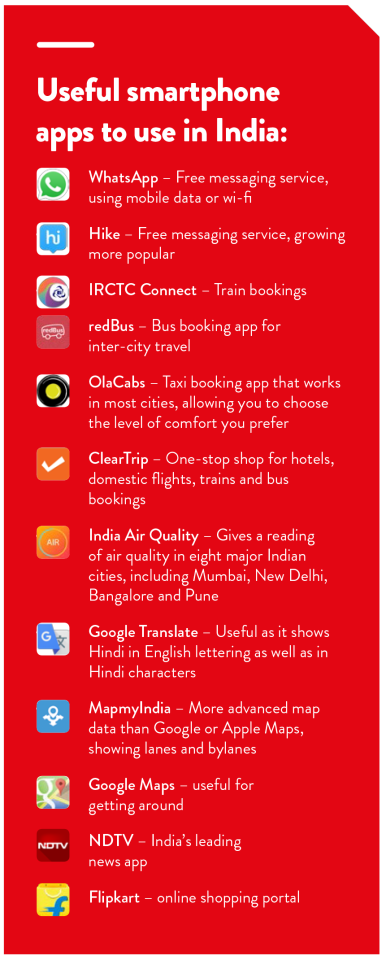
For more information, access the full India Country Starter Pack
You successfully shared the app
https://indiacsp.shareableapps.com/
Tap and hold link above to copy to clipboard.
Are you sure you want to delete this message?
Most of the following information on health and welfare in India has been provided by the Australian Government's Department of Foreign Affairs and Trade (DFAT). Australians should register on DFAT's website in case of an emergency and consult www.smartraveller.gov.au.
Before visiting India, Australians should take out comprehensive travel insurance that will cover any medical costs.
Medical facilities providing an adequate standard of treatment can be found in India's major cities. However, in remote and rural areas facilities can be very limited or unavailable. In the event of a serious illness or accident, medical evacuation may be necessary.
Cases of Influenza A (H1N1) have recently increased in India. If you are travelling to India, discuss influenza vaccination requirements with a health professional before leaving.
There is a high incidence of food-borne, water-borne and other infectious diseases in India (including meningitis, cholera, typhoid, hepatitis, tuberculosis, HIV/AIDS, diphtheria and rabies). Tap water in India is not safe to drink. Dengue fever, malaria and other mosquito-borne diseases are also a risk in India. Take strict precautions against being bitten by mosquitoes.
Violent protests and demonstrations occur sporadically and often spontaneously throughout India. Civil unrest and communal violence have in the past claimed a significant number of lives. Avoid protests and demonstrations as these may become violent.
Terrorism: Terrorism is a threat in India as it is elsewhere. In the past, terrorists have targeted areas frequented by tourists including hotels, markets, tourist sites, transport hubs and public transport networks and religious sites.
Crime: Women should take particular care in India, including in major cities and tourist destinations. Petty theft is common in crowded areas such as markets, trade fairs, expos and airports, as well as on buses, metros and trains.
For more information, access the full India Country Starter Pack
You successfully shared the app
https://indiacsp.shareableapps.com/
Tap and hold link above to copy to clipboard.
Are you sure you want to delete this message?

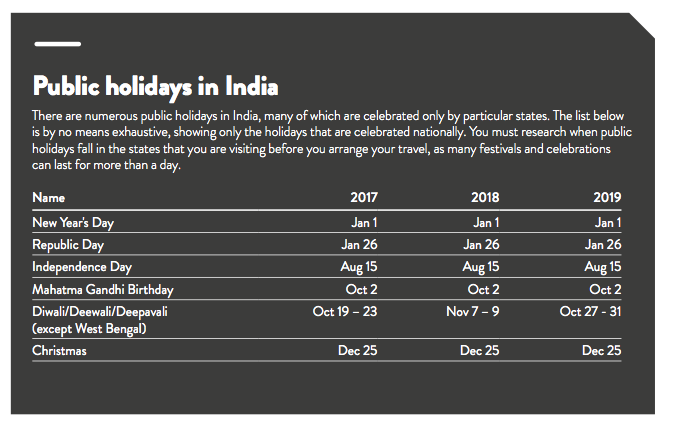
For more information, access the full India Country Starter Pack
You successfully shared the app
https://indiacsp.shareableapps.com/
Tap and hold link above to copy to clipboard.
Are you sure you want to delete this message?

Asialink Business provides high-calibre opportunities for Australian businesses to build the Asia capability of their executives and team members. Our business-focused cultural competency programs, professional development opportunities and practical research products allow businesses to develop essential knowledge of contemporary Asian markets, business environments, cultures and political landscapes.
You successfully shared the app
https://indiacsp.shareableapps.com/
Tap and hold link above to copy to clipboard.
Are you sure you want to delete this message?
You successfully shared the app
https://indiacsp.shareableapps.com/
Tap and hold link above to copy to clipboard.
Are you sure you want to delete this message?
You successfully shared the app
https://indiacsp.shareableapps.com/
Tap and hold link above to copy to clipboard.
Are you sure you want to delete this message?
Australian High Commission, India
1/50 G Shantipath, Chanakyapuri
New Delhi 110021
Tel: +91 11 4139 9900
Fax: +91 11 4149 4490
Web: www.india.highcommission.gov.au
The High Commission of India in Australia
3 Moonah Place
Yarralumla, ACT 2600
Tel: +61 2 8223 9909
Web: www.hcindia-au.org/
You successfully shared the app
https://indiacsp.shareableapps.com/
Tap and hold link above to copy to clipboard.
Are you sure you want to delete this message?
You successfully shared the app
https://indiacsp.shareableapps.com/
Tap and hold link above to copy to clipboard.
Are you sure you want to delete this message?
You successfully shared the app
https://indiacsp.shareableapps.com/
Tap and hold link above to copy to clipboard.
Are you sure you want to delete this message?
This app requires Google Chrome to continue. Tap the icon, copy link, then paste into Chrome
This app requires Google Chrome to continue. Tap the icon, Open in browser, then choose Chrome
India CSP
| App category: | Other |
| Updated: | January 6, 2019 |
| App Publisher: | Asialink Business |
| Compatible with: | iOS 6+, Android 4+, Blackberry 10+ and Windows Phone 8+. |
| Legals: | Terms of use |
You successfully shared the app
You successfully shared the app
https://indiacsp.shareableapps.com/
Tap and hold link above to copy to clipboard.
Are you sure you want to delete this message?
You successfully shared the app
https://indiacsp.shareableapps.com/
Tap and hold link above to copy to clipboard.
Are you sure you want to delete this message?